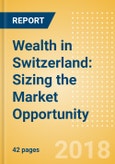Wealth in Switzerland: Sizing the Market Opportunity
Summary
"Wealth in Switzerland: Sizing the Market Opportunity", report analyzes Switzerland’s wealth and retail savings and investments markets, with a focus on the HNW segment. The report is based on our proprietary datasets.
Growth continued in the Swiss wealth market, and the country remains a popular destination for offshore investments. However, increasing tax transparency pressures, continued negative interest rates, and global macroeconomic risks will decelerate both resident and non-resident market growth in future years. Wealth managers will need to collaborate closely with clients to maintain revenues in this challenging new reality.
Specifically the report:
Scope
Reasons to buy
Summary
"Wealth in Switzerland: Sizing the Market Opportunity", report analyzes Switzerland’s wealth and retail savings and investments markets, with a focus on the HNW segment. The report is based on our proprietary datasets.
Growth continued in the Swiss wealth market, and the country remains a popular destination for offshore investments. However, increasing tax transparency pressures, continued negative interest rates, and global macroeconomic risks will decelerate both resident and non-resident market growth in future years. Wealth managers will need to collaborate closely with clients to maintain revenues in this challenging new reality.
Specifically the report:
- Sizes the affluent market (both by number of individuals and the value of their assets) using the author’s proprietary datasets.
- Examines HNW clients’ attitudes towards non-liquid asset classes such as property, commodities, and offshore investments.
- Analyzes which asset classes are favored by Swiss investors and how their preferences impact the growth of the overall savings and investments market.
- Evaluates the size of the retail non-resident (offshore) market in Switzerland and foreign investors’ preferences.
Scope
- At the end of 2017, affluent individuals held 94% of Switzerland’s total liquid assets - one of the largest proportions in the world.
- The value of liquid assets held by affluent individuals increased by 5.6% during the year, driven mostly by positive stock market performance boosting mutual funds and equity investments.
- Going forward, lethargic stock market performance and economic growth risks will lead to a decrease in the affluent individual population by 2022.
- With automatic exchange of information now in place Swiss secrecy benefits are reducing, affecting the profitability of the country’s private banks.
Reasons to buy
- Benchmark your share of the Swiss wealth market against the market’s current size.
- Forecast your future growth prospects using our projections for the market to 2022.
- Identify your most promising client segment by analyzing penetration of affluent individuals in Switzerland.
- Evaluate your HNW proposition by understanding how the ever-changing tax system affects your HNW clients.
- Review your offshore strategy and offering for non-resident investors by learning the dynamics in these markets.
Table of Contents
1. EXECUTIVE SUMMARY
2. THE SWISS WEALTH MARKET EXPANDED ONLY SLIGHTLY IN 2017 DUE TO SLOW ECONOMIC GROWTH
3. DEPOSITS CONSTITUTE OVER HALF OF LIQUID WEALTH IN SWITZERLAND
4. SWITZERLAND HAS BEEN LOSING ITS APPEAL AS AN OFFSHORE CENTER
5. APPENDIX
List of Tables
List of Figures
Companies Mentioned (Partial List)
A selection of companies mentioned in this report includes, but is not limited to:
- UBS
- Credit Suisse
- Zurich Insurance Group
- Novartis
- Roche Holdings
- Nestle








